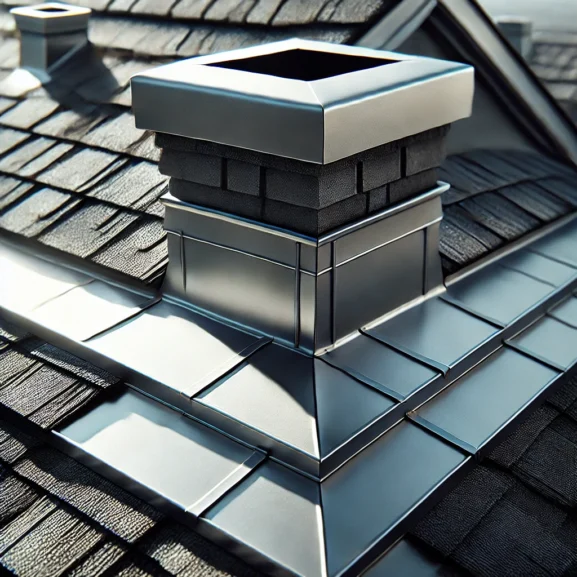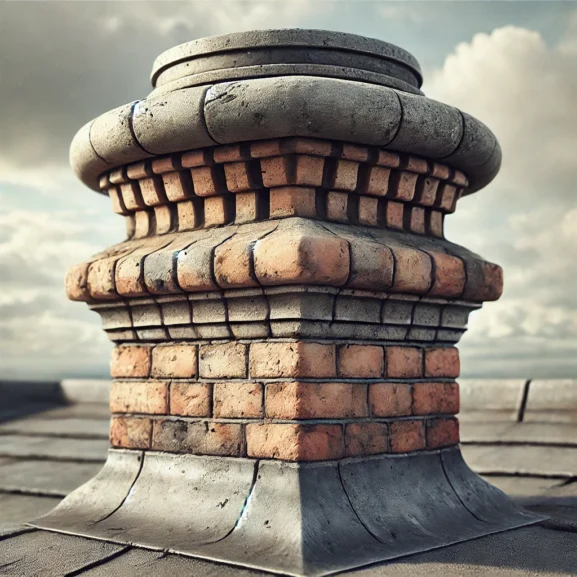Understanding and Preventing Spalling of Stone Chimneys: Essential Tips and Solutions
When we think of stone chimneys, we often imagine their timeless beauty and rustic charm. But, beneath that sturdy exterior, a hidden threat called spalling can wreak havoc. Spalling happens when stone surfaces start to flake or peel. This often occurs because moisture seeps into the stone. When temperatures drop, the moisture freezes and expands. As this freeze-thaw cycle repeats, the stone weakens and begins to deteriorate. This not only compromises the chimney’s structural integrity but also its aesthetic appeal.
Understanding the causes and signs of spalling is crucial for homeowners. To keep our stone chimneys looking good and working well, we need to address problems early. Here, we’ll look at what causes spalling, how to recognize it, and ways to prevent or fix it. Let’s jump into the world of stone chimneys and ensure they stand strong for years to come.

Spalling in Stone Chimneys: What Homeowners Need to Know
Spalling is a common problem in stone chimneys. Our weather can be unpredictable, making things worse. Spalling happens when moisture gets into the masonry. When it freezes and thaws, it causes the stone surface to flake or peel. These freeze-thaw cycles do more than damage the appearance. They can also weaken the structure of your chimney, which can lead to serious issues.
We might see signs of damage around the chimney. Look for bricks that are flaking or peeling. You may also find pieces of stone at the base of the chimney. It’s crucial to address spalling quickly to prevent further masonry deterioration. Ignoring it could mean more costly chimney masonry repairs in the future. We always say, better a stitch in time than a chimney in shambles!
Spalling prevention involves regular inspections and ensuring a waterproof seal on the chimney. Spotting early signs can save both time and money. When in doubt, let the professionals handle it; DIY fixes aren’t advisable. For expert advice, feel free to reach out to certified professionals for consultation. Press the easy button and leave it to us.
For more information on chimney safety, check out resources from reputable sites like the National Fire Protection Association or the Chimney Safety Institute of America. Protect that stone chimney from weather-related masonry damage and keep it solid through any storm.
Causes of Spalling
Understanding the causes of spalling in stone chimneys helps homeowners maintain these structures. Specific factors contribute significantly to masonry deterioration.
Weathering and Freeze-Thaw Cycles
Weather-related masonry damage occurs when cold winters and hot summers show up. Temperature fluctuations cause the stones to expand and contract. Water sneaks into cracks, causing brick flaking and freeze-thaw damage. As a result, spalling becomes evident. Spalling prevention involves regular inspections and applying a water-repellent sealant. We suggest skipping the DIY route on this one, or you might wind up like a snowman in July.
Poor Construction Materials
Quality materials make a big difference. Using subpar materials is like building a sandcastle in a rainstorm. Poor-quality bricks and improperly mixed mortar can’t handle environmental stress well. This leads to faster stone degradation. When the right materials aren’t used, the chimney’s lifespan shortens. As a result, more frequent masonry repairs are needed. Always consider professional advice to confirm the best materials for your area. A good stone is better than a stone that’s good at hiding weaknesses. Feel free to reach out to certified professionals to discuss your options.
Inadequate Maintenance
Lack of regular upkeep leads to moisture damage in chimneys. Cracks remain unnoticed if inspections aren’t performed regularly, and water infiltrates. Regular maintenance and timely inspections spotlight potential issues before becoming costly problems. Routine checks by professionals prevent more severe spalling treatment for chimneys. Let us know to help keep those chimneys standing tall and proud—no need for bashfulness.
Identifying Symptoms of Spalling
Spotting spalling early keeps your stone chimney looking great and prevents bigger headaches. Let’s jump into what those pesky symptoms look like.
Visible Surface Damage
Check your chimney for flaky bits or missing pieces. When chunks of stone or brick start flaking off, it’s a clear sign of chimney brick spalling. Weather-related masonry damage, like freeze-thaw cycles, often causes this. Imagine your chimney playing peek-a-boo, but not in a fun way. Look for:
- Missing or crumbling mortar
- Deterioration on the stone surface
- Discolored patches due to moisture damage
Keep an eye out for these signs. They’re less obvious than a raccoon in a top hat but still need attention.
Structural Cracks
Structural cracks bring out the serious side of spalling. If your chimney looks like it’s trying to start a spider web collection, call in the experts. These cracks don’t just affect the masonry. They show that the chimney’s structure is at risk. Watch for:
- Long vertical or horizontal cracks
- Joints separating in the masonry
- Gaps between stones
After a wild winter, these structural problems might creep up. Let’s tackle them before they lead to costly chimney masonry repairs.
Got concerns? feel free to reach out to certified professionals for consultation. Let’s ensure your chimney’s as safe as it is stylish.
Repairing Spalling in Stone Chimneys

Repairing spalling in stone chimneys involves several key steps. Whether we’re handling minor patch repairs or tackling bigger rebuilds, professional help makes a difference. Experts bring experience and skills to every job. This means repairs are done right and last a long time. Let’s explore the methods we use.
Patch Repair Methods
For stone chimneys exhibiting minor masonry deterioration, patch repair methods work wonders. Our experts clean the affected spots to remove debris and loosened material. Next, we apply a strong bonding agent. Then, we add a new layer of mortar. This fresh mortar is carefully mixed to match the existing color and texture. This technique addresses brick flaking and small-scale stone degradation effectively. While it seems simple, ensuring a good match takes skill. Home repairs can leave your chimney looking like a patchwork quilt. Trust the professionals for a clean, seamless job.
Adding a waterproof sealant helps protect repaired areas from moisture damage in chimneys. For homeowners, freeze-thaw damage is a frequent issue. This step helps prevent more spalling from happening.
Rebuilding Affected Sections
Sometimes, chimney masonry repairs require rebuilding large sections. This is needed when there is severe spalling. We first assess how deep the damage is. Then, we replace the broken bricks or stones with new ones. These new materials are weatherproof. This prevents weather-related masonry damage from worsening and strengthens the chimney’s structure.
During rebuilding, we ensure proper alignment and joint stability. This avoids future issues, especially in variable climates. Our skilled masons are experts with stones and bricks. They ensure your chimney keeps its beauty.
If you need stone chimney spalling repairs, feel free to reach out to certified professionals for consultation.
Preventing Future Spalling
Preventing spalling keeps stone chimneys in top shape. Let’s go over some practical steps to handle this. You don’t want your chimney to start shedding like a snake’s skin!
Regular Inspections
Routine check-ups detect chimney masonry issues early. We recommend scheduling inspections annually, especially after harsh winters. Professionals assess signs like brick flaking and stone degradation before they worsen. They also look for weather-related masonry damage, which can quickly lead to spalling. An expert eye catches subtle issues we might miss, saving both time and money.
Protective Coatings and Sealants
Applying protective coatings guards against moisture damage in chimneys. These coatings create a barrier against water, reducing freeze-thaw damage risks. Quality sealants help protect your chimney. They prevent damage to it. Think of them as an invisible raincoat. They keep moisture from harming your chimney’s health. Professionals apply sealants to match the masonry, ensuring minimal visual impact. This protection is vital in areas where weather is unpredictable.
Remember, we’ve got your back! Reach out to certified professionals for consultation to book a consultation with our professional team.
Essential Tips for Preventing Spalling and Maintaining Your Stone Chimney
By knowing the causes and signs of spalling, we can keep our stone chimneys in good shape. This helps ensure they stay safe and look great. Regular inspections and professional repairs help prevent moisture buildup and freeze-thaw damage. It’s also important to use quality materials and protective sealants. If we live in areas with harsh weather, these steps become even more important. By staying proactive and informed, we can keep our chimneys strong and looking great for years. If we need expert help, we should contact professionals. They can guide us in maintaining our chimneys with confidence.
Frequently Asked Questions
What is spalling in stone chimneys?
Spalling in stone chimneys happens when the stone surface flakes or peels. This is usually caused by moisture getting in and the freeze-thaw cycles. If not fixed quickly, it can cause the chimney to weaken. It can also make the chimney look less appealing.
How can I identify spalling in my chimney?
Signs of spalling are easy to spot. You might notice flaky bits or missing mortar. There could also be discolored patches caused by moisture. Structural cracks are another sign. Long gaps and separating joints show more serious damage. This is especially true after a harsh winter. Regular inspections can help identify these issues early.
Why is regular inspection of stone chimneys important?
Regular inspections are important. They help catch early signs of spalling. This can prevent serious damage and expensive repairs. You should inspect your chimney, especially after bad weather. This keeps it safe and looking good over time.
How can spalling be repaired?
Spalling can be fixed in two ways. For minor issues, we can use patch repairs. For more severe cases, we may need to rebuild sections. Experts clean affected areas, apply bonding agents, and use matching mortar mixes. Adding a waterproof sealant is essential to protect against further moisture damage.
How can I prevent spalling in my stone chimney?
To prevent spalling, conduct regular inspections, especially after harsh weather. Apply protective coatings and sealants to act as moisture barriers, reducing freeze-thaw damage. This proactive approach helps maintain the chimney’s structural integrity and appearance.
Should I attempt DIY repairs for spalling?
DIY repairs are not recommended for spalling. Professional help ensures proper repair methods, maintaining structural integrity and aesthetic appeal. It’s best to consult chimney experts for safe, effective solutions.
Are there specific resources I can consult for chimney maintenance?
Yes, consult trusted sources like the Chimney Safety Institute of America and the National Fire Protection Association. They provide reliable information to help you keep your chimney safe. They offer helpful guidance on chimney safety and maintenance. This will help keep your stone chimney durable and safe.
How can I schedule a professional consultation for my chimney?
To schedule a professional consultation, contact a qualified chimney service team. They can give expert advice. They also offer maintenance services. This helps keep your chimney safe and stylish. Look for companies offering free consultations to get started.


